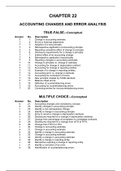Answers
Test Bank CHAPTER 22 ACCOUNTING CHANGES AND ERROR ANALYSIS
CHAPTER 22
ACCOUNTING CHANGES AND ERROR ANALYSIS
TRUE-FALSE—Conceptual
Answer No. Description
F 1. Change in accounting estimate.
T 2. Errors in financial statements.
F 3. Adoption of a new principle.
T 4. Retrospective application of accounting principle.
F 5. Reporting cumulative effect ...
[Show more]
Preview 3 out of 35 pages
-
October 18, 2020
-
35
-
2020/2021
-
Answers
-
Unknown
-
University
-
Test Bank CHAPTER 22 ACCOUNTING CHANGES AND ERROR ANALYSIS
All documents for this subject (1)
CHAPTER 22
ACCOUNTING CHANGES AND ERROR ANALYSIS
TRUE-FALSE—Conceptual
Answer No. Description
F 1. Change in accounting estimate.
T 2. Errors in financial statements.
F 3. Adoption of a new principle.
T 4. Retrospective application of accounting principle.
F 5. Reporting cumulative effect of change in principle.
T 6. Disclosure requirements for a change in principle.
T 7. Indirect effect of an accounting change.
T 8. Retrospective application impracticality.
F 9. Reporting changes in accounting estimates.
T 10. Change in principle vs. change in estimate.
F 11. Accounting for change in depreciation method.
F 12. Accounting for change in reporting entities.
T 13. Example of a change in reporting entities.
F 14. Accounting error vs. change in estimate.
T 15. Accounting for corrections of errors.
T 16. New principle created by FASB standard.
F 17. Balance sheet errors.
F 18. Definition of counterbalancing errors.
T 19. Accounting for counterbalancing errors.
T 20. Correcting entries for noncounterbalancing errors.
MULTIPLE CHOICE—Conceptual
Answer No. Description
b 21. Accounting changes and consistency concept.
b 22. Identify changes in accounting principle.
c 23. Identify a non-retrospective change.
d 24. Identify a change in accounting principle.
a 25. Entry to record a change in depreciation methods.
c 26. Disclosures required for a change in depreciation methods.
c 27. Change from percentage-of-completion to completed-contracts.
d 28. Disclosures required for a change from LIFO to FIFO.
b 29. Change from FIFO to LIFO.
c 30. Change in accounting estimate.
a 31. Change in accounting estimate.
b 32. Identify a change in accounting estimate.
b 33. Change in accounting estimate.
c 34. Identify a change in accounting estimate.
d 35. Identify a change in reporting entity.
c 36. Retroactive reporting a change in reporting entity.
c 37. Identify a correction of an error.
b 38. Identification of counterbalancing errors.
,22 - 2 Test Bank for Intermediate Accounting, Fourteenth Edition
MULTIPLE CHOICE—Conceptual (cont.)
Answer No. Description
c 39. Impact of failure to record purchase and count ending inventory.
c 40. Impact of failure to record purchase and count ending inventory.
MULTIPLE CHOICE—Computational
Answer No. Description
b 41. Calculate cumulative effect of a change in depreciation method.
b 42. Calculate cumulative effect of a change in depreciation method.
c 43. Calculate net income with change in accounting principle with tax effects.
d 44. Calculate cumulative effect of accounting change.
c 45. Calculate depreciation expense after change in accounting principle.
d 46. Calculate cumulative effect of a change on retained earnings.
b 47. Calculate cumulative effect of a change on retained earnings.
c 48. Compute depreciation expense after a change in depreciation methods.
b 49. Calculate cumulative effect of a change in inventory methods.
c 50. Calculate net income after a change to LIFO method.
a 51. Calculate net income with change from FIFO to LIFO.
b 52. Calculate depreciation after a change in estimate.
a 53. Calculate net income with change in an accounting estimate.
a 54. Determine depreciation expense after a change in estimated life.
a 55. Compute effect of errors on income before taxes.
c 56. Compute effect of errors on retained earnings.
d 57. Calculate effect of errors on net income.
c 58. Calculate effect of errors on working capital.
c 59. Calculate effect of errors on retained earnings.
a 60. Effect of errors on income and retained earnings.
a 61. Calculate effect of errors on net income.
b 62. Calculate effect of errors on retained earnings.
c 63. Calculate effect of errors on working capital.
d 64. Determine cumulative effect of error on income statement.
c 65. Determine the understatement of retained earnings.
a 66. Calculate effect of error on net income.
c 67. Compute effect of error on retained earnings.
MULTIPLE CHOICE—CPA Adapted
Answer No. Description
b 68. Identify a change in accounting principle.
c 69. Cumulative effect of a change from weighted-average to LIFO.
a 70. Reporting a change to FIFO from LIFO.
a 71. Balance of accumulated depreciation after a change in estimate.
b 72. Determine carrying value of a patent with a change in estimate.
d 73. Reporting royalty income when amount realized differs from estimate.
b 74. Depreciation expense to be recorded following an error.
c 75. Impact of failure to accrue insurance costs.
a 76. Retained earnings balance with multiple errors.
, Accounting Changes and Error Analysis 22 - 3
EXERCISES
Item Description
E22-77 Matching accounting changes to situations.
E22-78 How changes or corrections are recognized.
E22-79 Matching disclosures to situations.
E22-80 Change in accounting principle.
E22-81 Change in estimate, change in entity, corrections of errors.
E22-82 Changes in depreciation methods, estimates.
E22-83 Noncounterbalancing error.
E22-84 Effects of errors.
E22-85 Effects of errors.
PROBLEMS
Item Description
P22-86 Accounting for changes and error corrections.
P22-87 Corrections of errors.
P22-88 Error corrections and adjustments.
CHAPTER LEARNING OBJECTIVES
1. Identify the types of accounting changes.
2. Describe the accounting for changes in accounting principles.
3. Understand how to account for retrospective accounting changes.
4. Understand how to account for impracticable changes.
5. Describe the accounting for changes in estimates.
6. Identify changes in a reporting entity.
7. Describe the accounting for correction of errors.
8. Identify economic motives for changing accounting methods.
9. Analyze the effect of errors.




